Comprehensive Report: Managing Energy Resources and Regulations
VerifiedAdded on 2020/11/23
|10
|3029
|145
Report
AI Summary
This report provides a detailed analysis of managing energy resources and regulations, focusing on key strategies employed in the United Kingdom's energy sector. It begins with an introduction to energy and its various forms, highlighting the role of EDF Energy in electricity generation and distribution. The report then delves into Demand Side Management (DSM) and Demand Side Response (DSR), explaining their roles in optimizing energy consumption, reducing electricity bills, and shifting consumption patterns. It explores the benefits of DSR, including cost reduction and revenue generation through schemes like Firm Frequency Response and capacity markets. The report further examines Distributed Generation (DG), discussing its advantages over centralized power plants and the role of technologies like wind turbines and solar cells. The report also covers demand reduction strategies, emphasizing their importance in achieving a low-carbon future and supporting flexible business opportunities. The report concludes by summarizing the importance of these strategies in the context of EDF Energy and the UK energy market, highlighting the importance of these strategies for sustainable energy management.
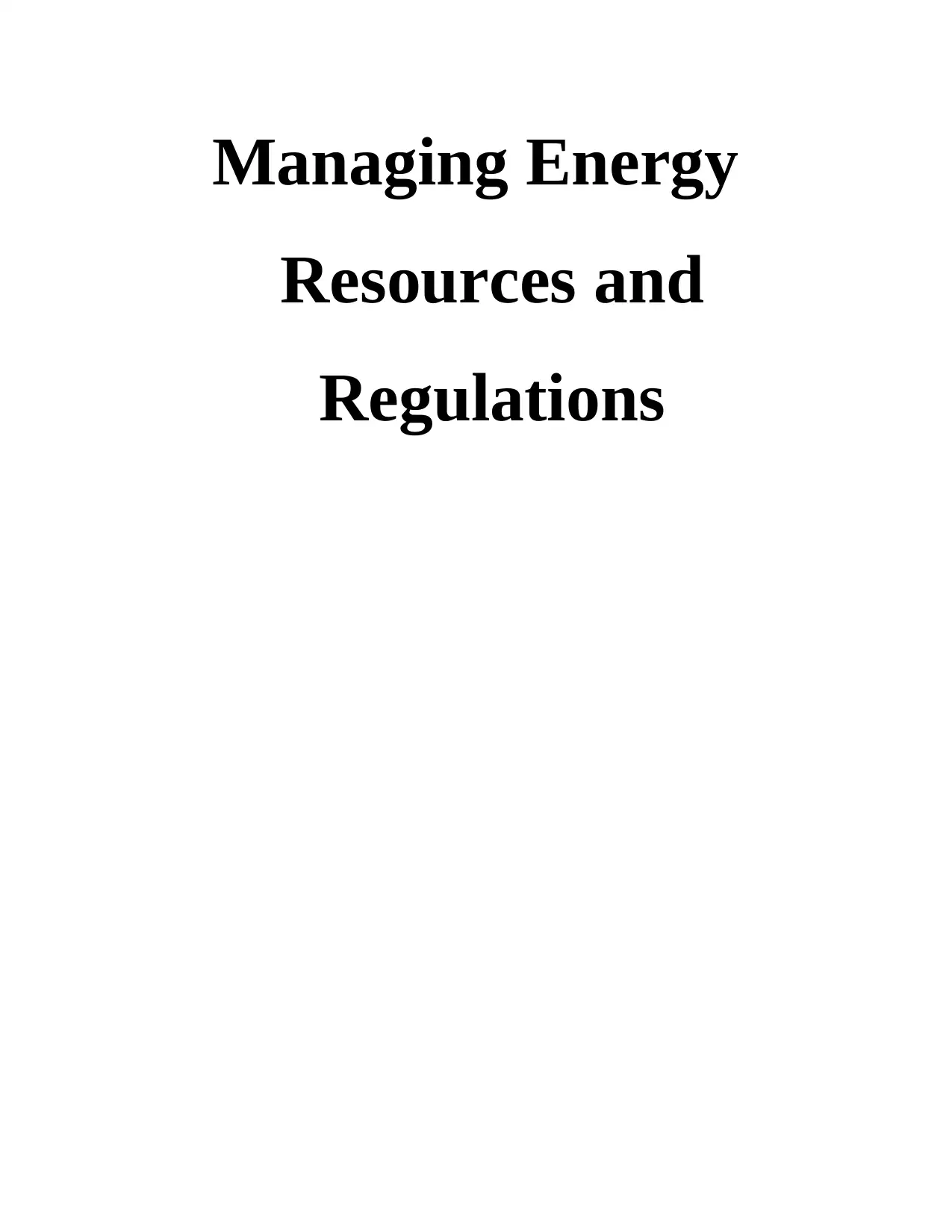
Managing Energy
Resources and
Regulations
Resources and
Regulations
Paraphrase This Document
Need a fresh take? Get an instant paraphrase of this document with our AI Paraphraser
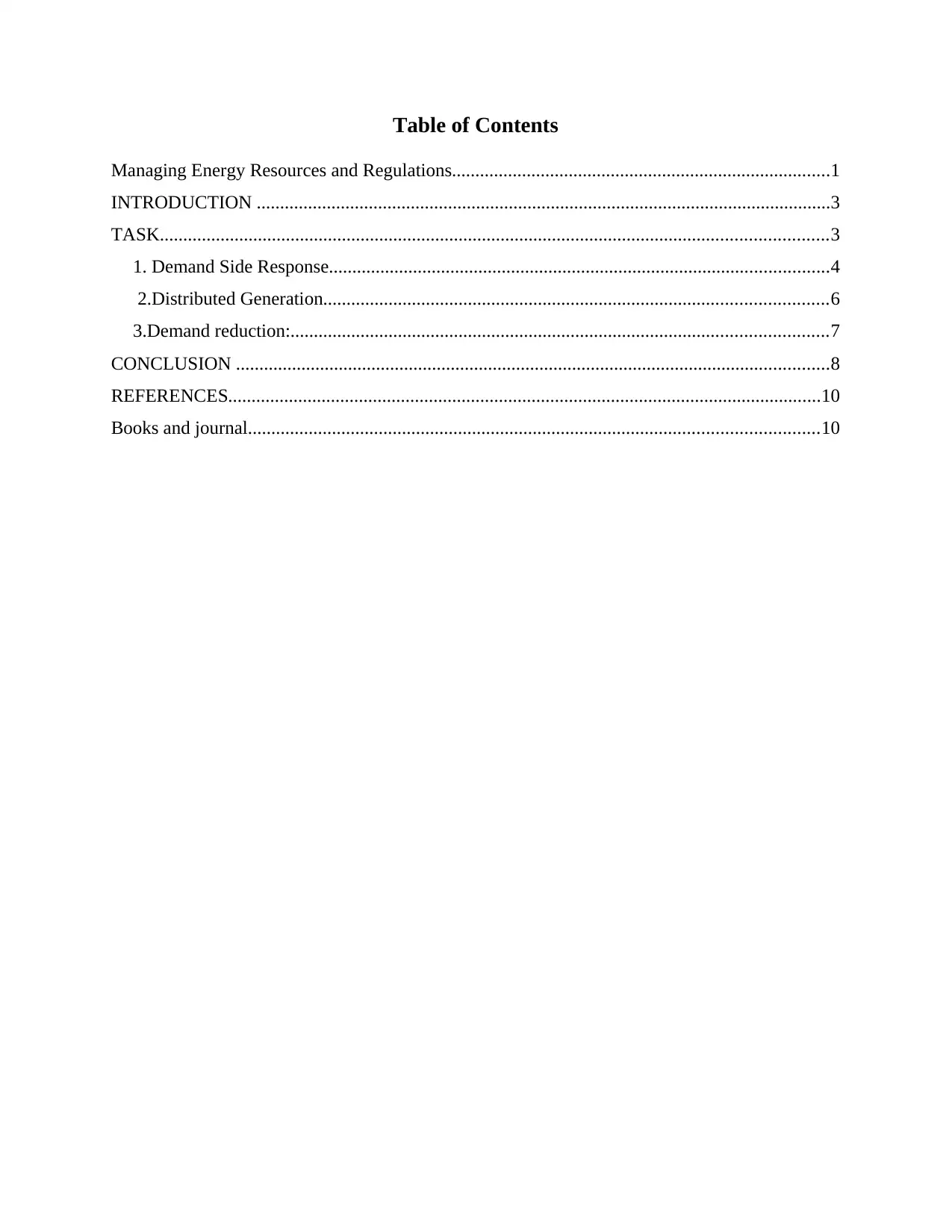
Table of Contents
Managing Energy Resources and Regulations.................................................................................1
INTRODUCTION ...........................................................................................................................3
TASK...............................................................................................................................................3
1. Demand Side Response...........................................................................................................4
2.Distributed Generation............................................................................................................6
3.Demand reduction:...................................................................................................................7
CONCLUSION ...............................................................................................................................8
REFERENCES...............................................................................................................................10
Books and journal..........................................................................................................................10
Managing Energy Resources and Regulations.................................................................................1
INTRODUCTION ...........................................................................................................................3
TASK...............................................................................................................................................3
1. Demand Side Response...........................................................................................................4
2.Distributed Generation............................................................................................................6
3.Demand reduction:...................................................................................................................7
CONCLUSION ...............................................................................................................................8
REFERENCES...............................................................................................................................10
Books and journal..........................................................................................................................10
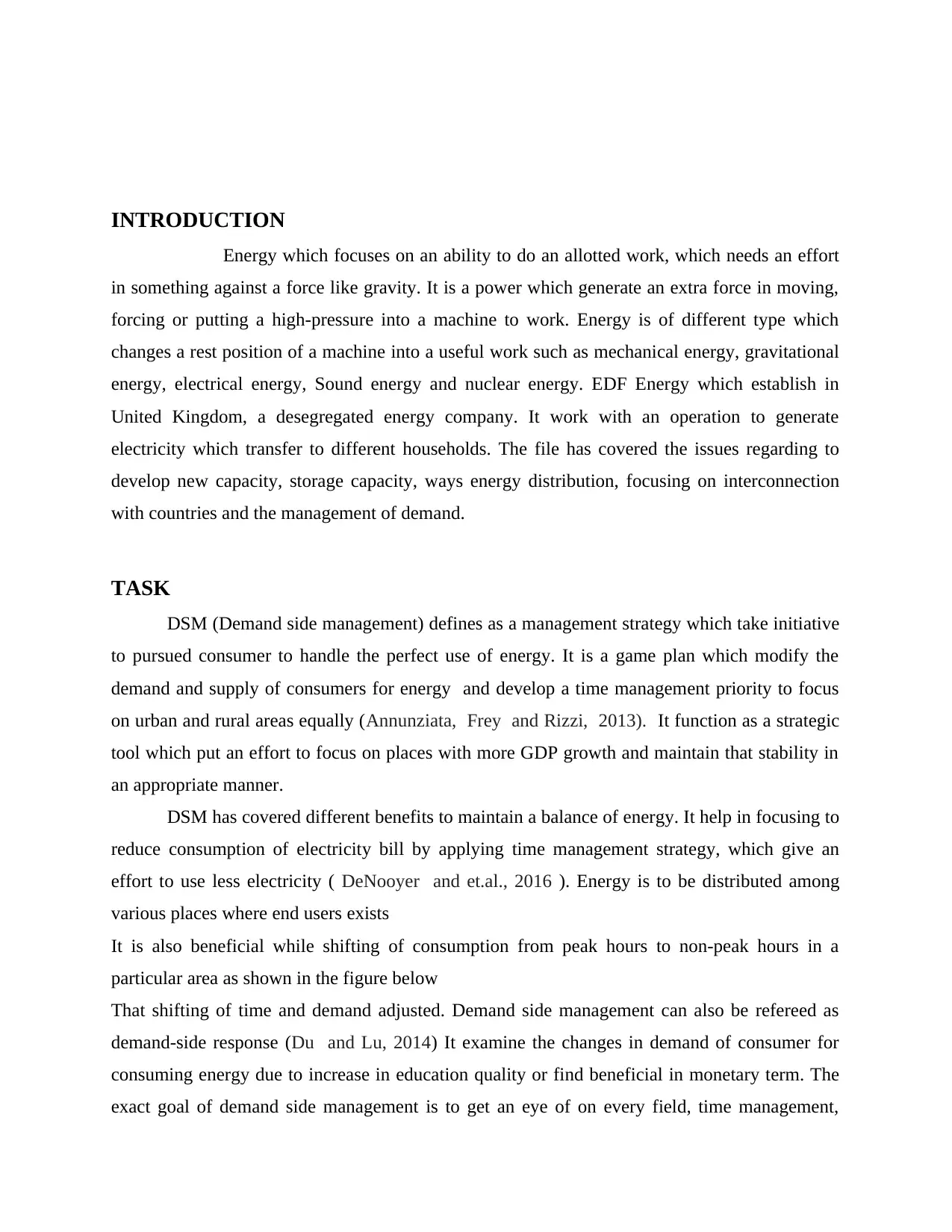
INTRODUCTION
Energy which focuses on an ability to do an allotted work, which needs an effort
in something against a force like gravity. It is a power which generate an extra force in moving,
forcing or putting a high-pressure into a machine to work. Energy is of different type which
changes a rest position of a machine into a useful work such as mechanical energy, gravitational
energy, electrical energy, Sound energy and nuclear energy. EDF Energy which establish in
United Kingdom, a desegregated energy company. It work with an operation to generate
electricity which transfer to different households. The file has covered the issues regarding to
develop new capacity, storage capacity, ways energy distribution, focusing on interconnection
with countries and the management of demand.
TASK
DSM (Demand side management) defines as a management strategy which take initiative
to pursued consumer to handle the perfect use of energy. It is a game plan which modify the
demand and supply of consumers for energy and develop a time management priority to focus
on urban and rural areas equally (Annunziata, Frey and Rizzi, 2013). It function as a strategic
tool which put an effort to focus on places with more GDP growth and maintain that stability in
an appropriate manner.
DSM has covered different benefits to maintain a balance of energy. It help in focusing to
reduce consumption of electricity bill by applying time management strategy, which give an
effort to use less electricity ( DeNooyer and et.al., 2016 ). Energy is to be distributed among
various places where end users exists
It is also beneficial while shifting of consumption from peak hours to non-peak hours in a
particular area as shown in the figure below
That shifting of time and demand adjusted. Demand side management can also be refereed as
demand-side response (Du and Lu, 2014) It examine the changes in demand of consumer for
consuming energy due to increase in education quality or find beneficial in monetary term. The
exact goal of demand side management is to get an eye of on every field, time management,
Energy which focuses on an ability to do an allotted work, which needs an effort
in something against a force like gravity. It is a power which generate an extra force in moving,
forcing or putting a high-pressure into a machine to work. Energy is of different type which
changes a rest position of a machine into a useful work such as mechanical energy, gravitational
energy, electrical energy, Sound energy and nuclear energy. EDF Energy which establish in
United Kingdom, a desegregated energy company. It work with an operation to generate
electricity which transfer to different households. The file has covered the issues regarding to
develop new capacity, storage capacity, ways energy distribution, focusing on interconnection
with countries and the management of demand.
TASK
DSM (Demand side management) defines as a management strategy which take initiative
to pursued consumer to handle the perfect use of energy. It is a game plan which modify the
demand and supply of consumers for energy and develop a time management priority to focus
on urban and rural areas equally (Annunziata, Frey and Rizzi, 2013). It function as a strategic
tool which put an effort to focus on places with more GDP growth and maintain that stability in
an appropriate manner.
DSM has covered different benefits to maintain a balance of energy. It help in focusing to
reduce consumption of electricity bill by applying time management strategy, which give an
effort to use less electricity ( DeNooyer and et.al., 2016 ). Energy is to be distributed among
various places where end users exists
It is also beneficial while shifting of consumption from peak hours to non-peak hours in a
particular area as shown in the figure below
That shifting of time and demand adjusted. Demand side management can also be refereed as
demand-side response (Du and Lu, 2014) It examine the changes in demand of consumer for
consuming energy due to increase in education quality or find beneficial in monetary term. The
exact goal of demand side management is to get an eye of on every field, time management,
⊘ This is a preview!⊘
Do you want full access?
Subscribe today to unlock all pages.

Trusted by 1+ million students worldwide
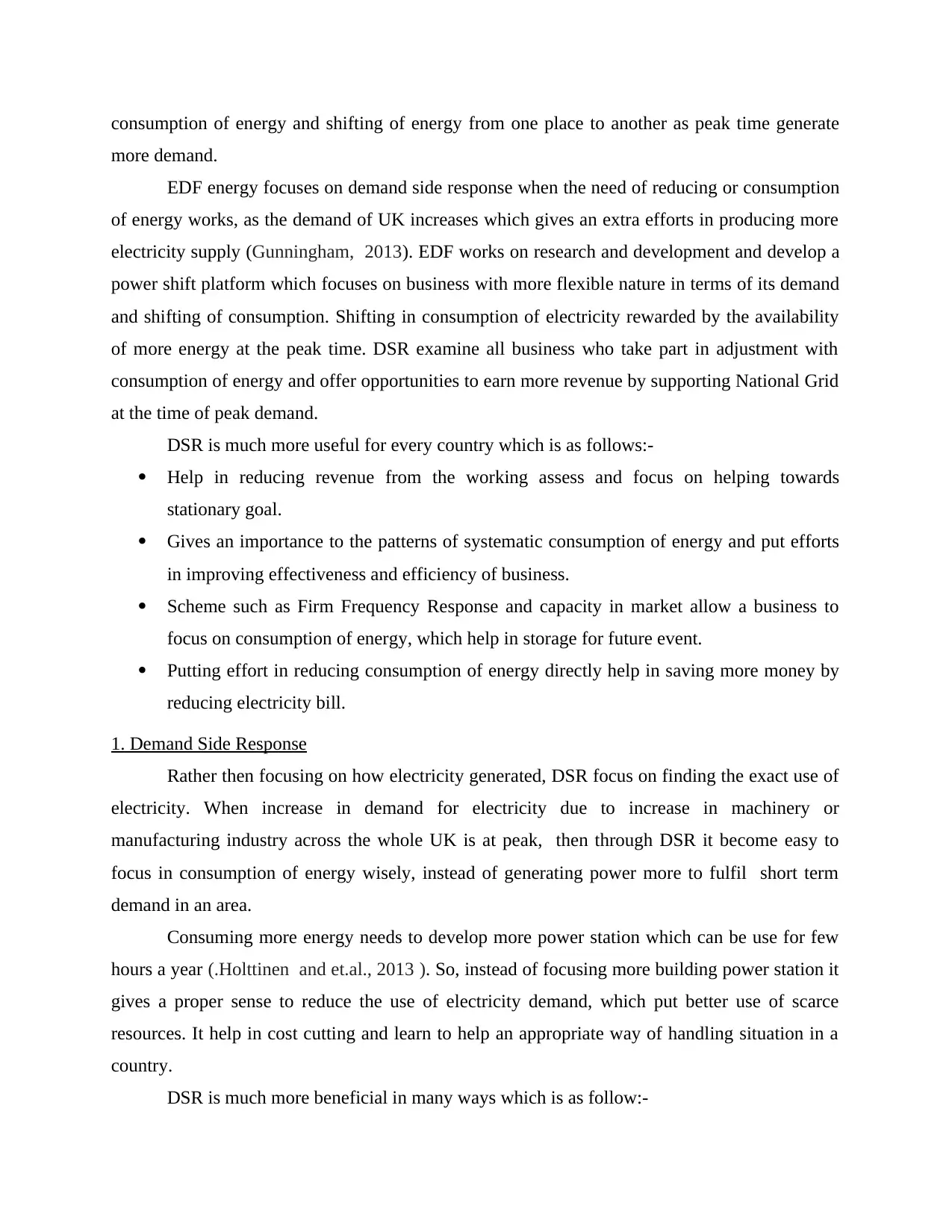
consumption of energy and shifting of energy from one place to another as peak time generate
more demand.
EDF energy focuses on demand side response when the need of reducing or consumption
of energy works, as the demand of UK increases which gives an extra efforts in producing more
electricity supply (Gunningham, 2013). EDF works on research and development and develop a
power shift platform which focuses on business with more flexible nature in terms of its demand
and shifting of consumption. Shifting in consumption of electricity rewarded by the availability
of more energy at the peak time. DSR examine all business who take part in adjustment with
consumption of energy and offer opportunities to earn more revenue by supporting National Grid
at the time of peak demand.
DSR is much more useful for every country which is as follows:-
Help in reducing revenue from the working assess and focus on helping towards
stationary goal.
Gives an importance to the patterns of systematic consumption of energy and put efforts
in improving effectiveness and efficiency of business.
Scheme such as Firm Frequency Response and capacity in market allow a business to
focus on consumption of energy, which help in storage for future event.
Putting effort in reducing consumption of energy directly help in saving more money by
reducing electricity bill.
1. Demand Side Response
Rather then focusing on how electricity generated, DSR focus on finding the exact use of
electricity. When increase in demand for electricity due to increase in machinery or
manufacturing industry across the whole UK is at peak, then through DSR it become easy to
focus in consumption of energy wisely, instead of generating power more to fulfil short term
demand in an area.
Consuming more energy needs to develop more power station which can be use for few
hours a year (.Holttinen and et.al., 2013 ). So, instead of focusing more building power station it
gives a proper sense to reduce the use of electricity demand, which put better use of scarce
resources. It help in cost cutting and learn to help an appropriate way of handling situation in a
country.
DSR is much more beneficial in many ways which is as follow:-
more demand.
EDF energy focuses on demand side response when the need of reducing or consumption
of energy works, as the demand of UK increases which gives an extra efforts in producing more
electricity supply (Gunningham, 2013). EDF works on research and development and develop a
power shift platform which focuses on business with more flexible nature in terms of its demand
and shifting of consumption. Shifting in consumption of electricity rewarded by the availability
of more energy at the peak time. DSR examine all business who take part in adjustment with
consumption of energy and offer opportunities to earn more revenue by supporting National Grid
at the time of peak demand.
DSR is much more useful for every country which is as follows:-
Help in reducing revenue from the working assess and focus on helping towards
stationary goal.
Gives an importance to the patterns of systematic consumption of energy and put efforts
in improving effectiveness and efficiency of business.
Scheme such as Firm Frequency Response and capacity in market allow a business to
focus on consumption of energy, which help in storage for future event.
Putting effort in reducing consumption of energy directly help in saving more money by
reducing electricity bill.
1. Demand Side Response
Rather then focusing on how electricity generated, DSR focus on finding the exact use of
electricity. When increase in demand for electricity due to increase in machinery or
manufacturing industry across the whole UK is at peak, then through DSR it become easy to
focus in consumption of energy wisely, instead of generating power more to fulfil short term
demand in an area.
Consuming more energy needs to develop more power station which can be use for few
hours a year (.Holttinen and et.al., 2013 ). So, instead of focusing more building power station it
gives a proper sense to reduce the use of electricity demand, which put better use of scarce
resources. It help in cost cutting and learn to help an appropriate way of handling situation in a
country.
DSR is much more beneficial in many ways which is as follow:-
Paraphrase This Document
Need a fresh take? Get an instant paraphrase of this document with our AI Paraphraser
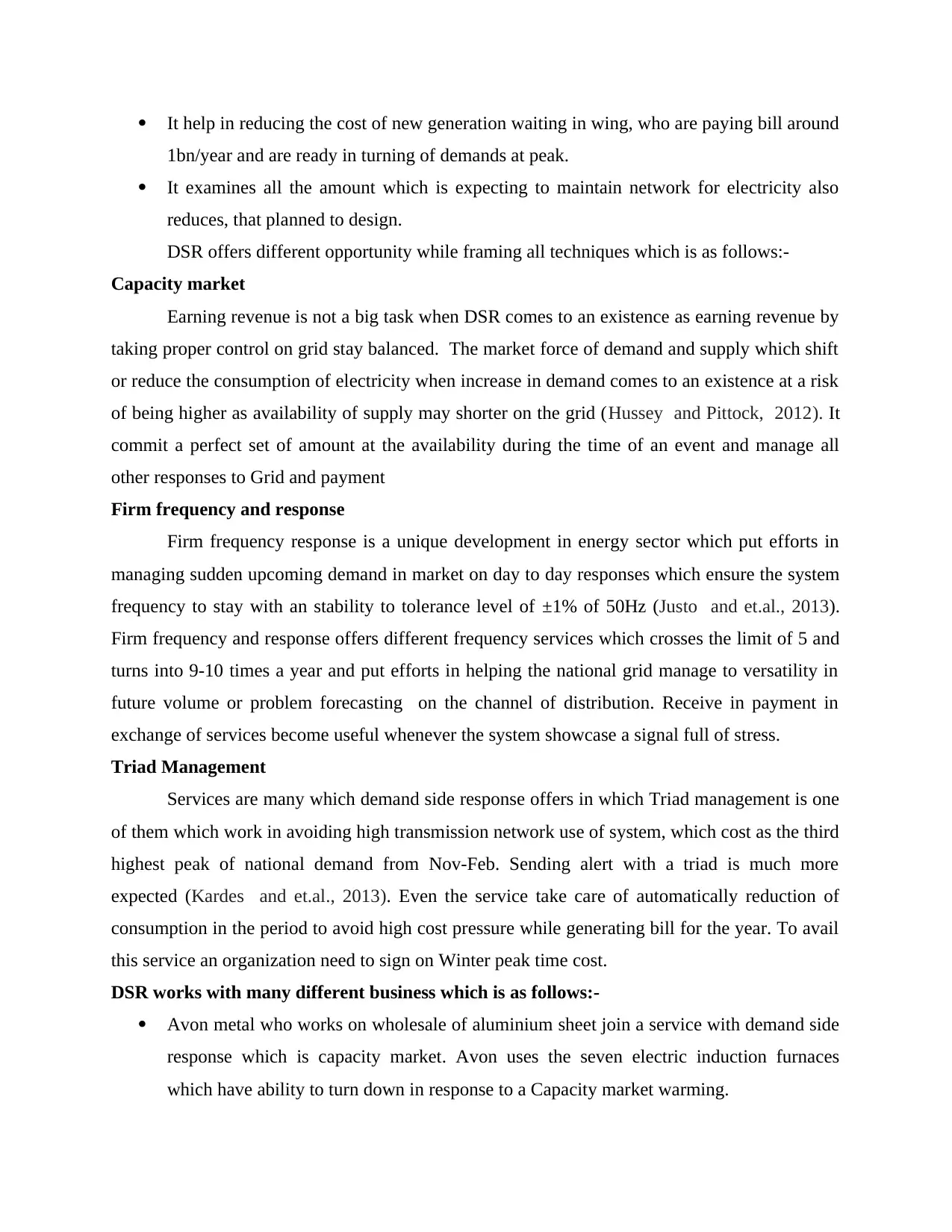
It help in reducing the cost of new generation waiting in wing, who are paying bill around
1bn/year and are ready in turning of demands at peak.
It examines all the amount which is expecting to maintain network for electricity also
reduces, that planned to design.
DSR offers different opportunity while framing all techniques which is as follows:-
Capacity market
Earning revenue is not a big task when DSR comes to an existence as earning revenue by
taking proper control on grid stay balanced. The market force of demand and supply which shift
or reduce the consumption of electricity when increase in demand comes to an existence at a risk
of being higher as availability of supply may shorter on the grid (Hussey and Pittock, 2012). It
commit a perfect set of amount at the availability during the time of an event and manage all
other responses to Grid and payment
Firm frequency and response
Firm frequency response is a unique development in energy sector which put efforts in
managing sudden upcoming demand in market on day to day responses which ensure the system
frequency to stay with an stability to tolerance level of ±1% of 50Hz (Justo and et.al., 2013).
Firm frequency and response offers different frequency services which crosses the limit of 5 and
turns into 9-10 times a year and put efforts in helping the national grid manage to versatility in
future volume or problem forecasting on the channel of distribution. Receive in payment in
exchange of services become useful whenever the system showcase a signal full of stress.
Triad Management
Services are many which demand side response offers in which Triad management is one
of them which work in avoiding high transmission network use of system, which cost as the third
highest peak of national demand from Nov-Feb. Sending alert with a triad is much more
expected (Kardes and et.al., 2013). Even the service take care of automatically reduction of
consumption in the period to avoid high cost pressure while generating bill for the year. To avail
this service an organization need to sign on Winter peak time cost.
DSR works with many different business which is as follows:-
Avon metal who works on wholesale of aluminium sheet join a service with demand side
response which is capacity market. Avon uses the seven electric induction furnaces
which have ability to turn down in response to a Capacity market warming.
1bn/year and are ready in turning of demands at peak.
It examines all the amount which is expecting to maintain network for electricity also
reduces, that planned to design.
DSR offers different opportunity while framing all techniques which is as follows:-
Capacity market
Earning revenue is not a big task when DSR comes to an existence as earning revenue by
taking proper control on grid stay balanced. The market force of demand and supply which shift
or reduce the consumption of electricity when increase in demand comes to an existence at a risk
of being higher as availability of supply may shorter on the grid (Hussey and Pittock, 2012). It
commit a perfect set of amount at the availability during the time of an event and manage all
other responses to Grid and payment
Firm frequency and response
Firm frequency response is a unique development in energy sector which put efforts in
managing sudden upcoming demand in market on day to day responses which ensure the system
frequency to stay with an stability to tolerance level of ±1% of 50Hz (Justo and et.al., 2013).
Firm frequency and response offers different frequency services which crosses the limit of 5 and
turns into 9-10 times a year and put efforts in helping the national grid manage to versatility in
future volume or problem forecasting on the channel of distribution. Receive in payment in
exchange of services become useful whenever the system showcase a signal full of stress.
Triad Management
Services are many which demand side response offers in which Triad management is one
of them which work in avoiding high transmission network use of system, which cost as the third
highest peak of national demand from Nov-Feb. Sending alert with a triad is much more
expected (Kardes and et.al., 2013). Even the service take care of automatically reduction of
consumption in the period to avoid high cost pressure while generating bill for the year. To avail
this service an organization need to sign on Winter peak time cost.
DSR works with many different business which is as follows:-
Avon metal who works on wholesale of aluminium sheet join a service with demand side
response which is capacity market. Avon uses the seven electric induction furnaces
which have ability to turn down in response to a Capacity market warming.
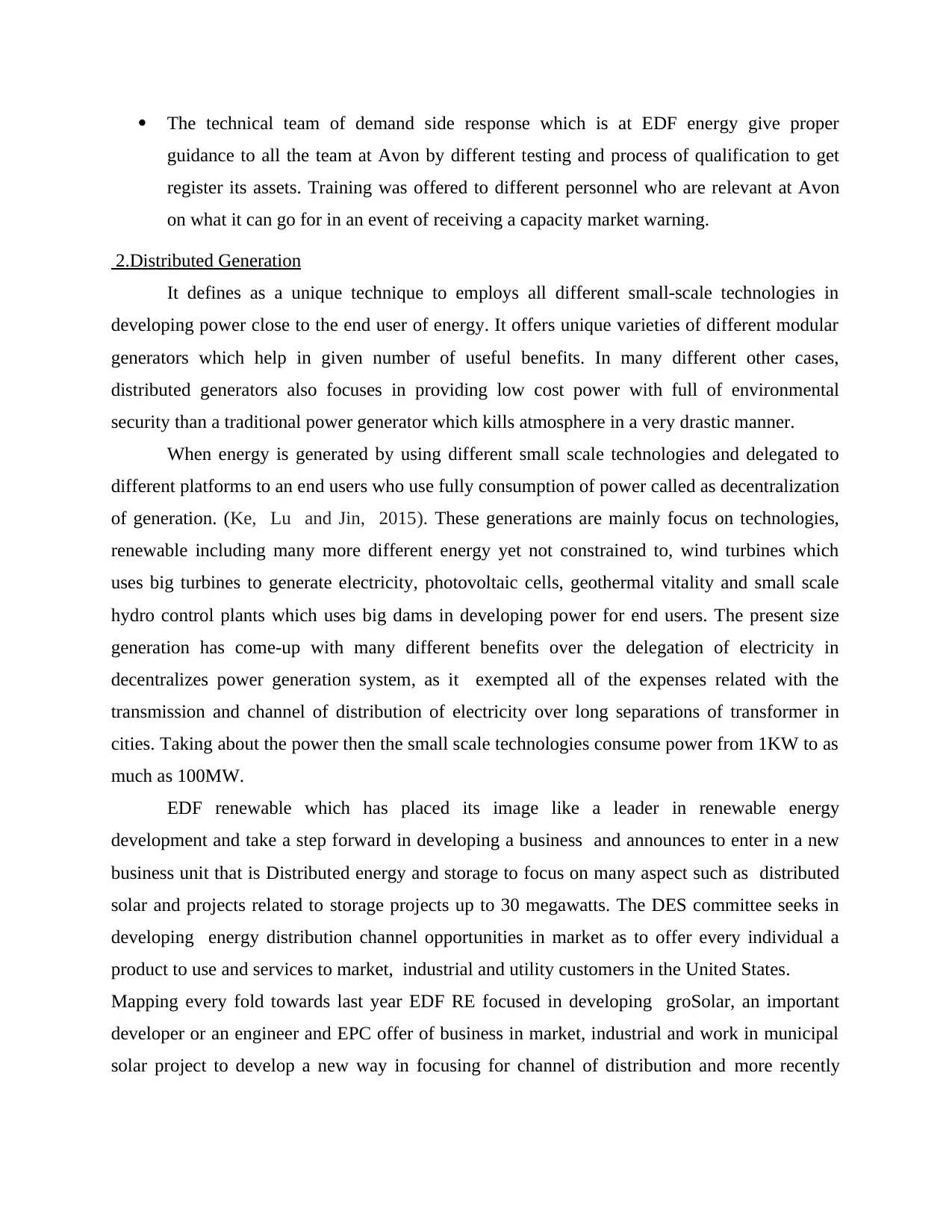
The technical team of demand side response which is at EDF energy give proper
guidance to all the team at Avon by different testing and process of qualification to get
register its assets. Training was offered to different personnel who are relevant at Avon
on what it can go for in an event of receiving a capacity market warning.
2.Distributed Generation
It defines as a unique technique to employs all different small-scale technologies in
developing power close to the end user of energy. It offers unique varieties of different modular
generators which help in given number of useful benefits. In many different other cases,
distributed generators also focuses in providing low cost power with full of environmental
security than a traditional power generator which kills atmosphere in a very drastic manner.
When energy is generated by using different small scale technologies and delegated to
different platforms to an end users who use fully consumption of power called as decentralization
of generation. (Ke, Lu and Jin, 2015). These generations are mainly focus on technologies,
renewable including many more different energy yet not constrained to, wind turbines which
uses big turbines to generate electricity, photovoltaic cells, geothermal vitality and small scale
hydro control plants which uses big dams in developing power for end users. The present size
generation has come-up with many different benefits over the delegation of electricity in
decentralizes power generation system, as it exempted all of the expenses related with the
transmission and channel of distribution of electricity over long separations of transformer in
cities. Taking about the power then the small scale technologies consume power from 1KW to as
much as 100MW.
EDF renewable which has placed its image like a leader in renewable energy
development and take a step forward in developing a business and announces to enter in a new
business unit that is Distributed energy and storage to focus on many aspect such as distributed
solar and projects related to storage projects up to 30 megawatts. The DES committee seeks in
developing energy distribution channel opportunities in market as to offer every individual a
product to use and services to market, industrial and utility customers in the United States.
Mapping every fold towards last year EDF RE focused in developing groSolar, an important
developer or an engineer and EPC offer of business in market, industrial and work in municipal
solar project to develop a new way in focusing for channel of distribution and more recently
guidance to all the team at Avon by different testing and process of qualification to get
register its assets. Training was offered to different personnel who are relevant at Avon
on what it can go for in an event of receiving a capacity market warning.
2.Distributed Generation
It defines as a unique technique to employs all different small-scale technologies in
developing power close to the end user of energy. It offers unique varieties of different modular
generators which help in given number of useful benefits. In many different other cases,
distributed generators also focuses in providing low cost power with full of environmental
security than a traditional power generator which kills atmosphere in a very drastic manner.
When energy is generated by using different small scale technologies and delegated to
different platforms to an end users who use fully consumption of power called as decentralization
of generation. (Ke, Lu and Jin, 2015). These generations are mainly focus on technologies,
renewable including many more different energy yet not constrained to, wind turbines which
uses big turbines to generate electricity, photovoltaic cells, geothermal vitality and small scale
hydro control plants which uses big dams in developing power for end users. The present size
generation has come-up with many different benefits over the delegation of electricity in
decentralizes power generation system, as it exempted all of the expenses related with the
transmission and channel of distribution of electricity over long separations of transformer in
cities. Taking about the power then the small scale technologies consume power from 1KW to as
much as 100MW.
EDF renewable which has placed its image like a leader in renewable energy
development and take a step forward in developing a business and announces to enter in a new
business unit that is Distributed energy and storage to focus on many aspect such as distributed
solar and projects related to storage projects up to 30 megawatts. The DES committee seeks in
developing energy distribution channel opportunities in market as to offer every individual a
product to use and services to market, industrial and utility customers in the United States.
Mapping every fold towards last year EDF RE focused in developing groSolar, an important
developer or an engineer and EPC offer of business in market, industrial and work in municipal
solar project to develop a new way in focusing for channel of distribution and more recently
⊘ This is a preview!⊘
Do you want full access?
Subscribe today to unlock all pages.

Trusted by 1+ million students worldwide
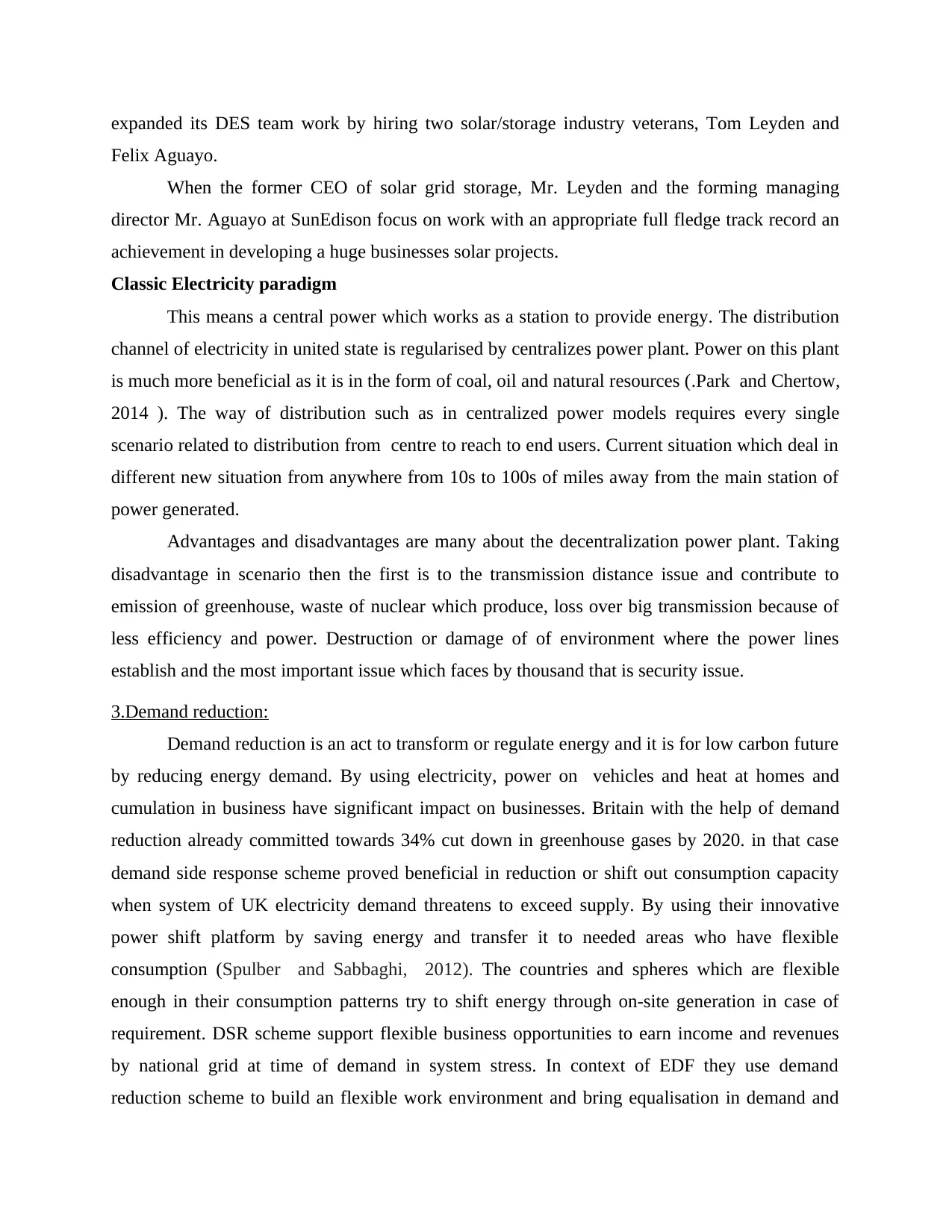
expanded its DES team work by hiring two solar/storage industry veterans, Tom Leyden and
Felix Aguayo.
When the former CEO of solar grid storage, Mr. Leyden and the forming managing
director Mr. Aguayo at SunEdison focus on work with an appropriate full fledge track record an
achievement in developing a huge businesses solar projects.
Classic Electricity paradigm
This means a central power which works as a station to provide energy. The distribution
channel of electricity in united state is regularised by centralizes power plant. Power on this plant
is much more beneficial as it is in the form of coal, oil and natural resources (.Park and Chertow,
2014 ). The way of distribution such as in centralized power models requires every single
scenario related to distribution from centre to reach to end users. Current situation which deal in
different new situation from anywhere from 10s to 100s of miles away from the main station of
power generated.
Advantages and disadvantages are many about the decentralization power plant. Taking
disadvantage in scenario then the first is to the transmission distance issue and contribute to
emission of greenhouse, waste of nuclear which produce, loss over big transmission because of
less efficiency and power. Destruction or damage of of environment where the power lines
establish and the most important issue which faces by thousand that is security issue.
3.Demand reduction:
Demand reduction is an act to transform or regulate energy and it is for low carbon future
by reducing energy demand. By using electricity, power on vehicles and heat at homes and
cumulation in business have significant impact on businesses. Britain with the help of demand
reduction already committed towards 34% cut down in greenhouse gases by 2020. in that case
demand side response scheme proved beneficial in reduction or shift out consumption capacity
when system of UK electricity demand threatens to exceed supply. By using their innovative
power shift platform by saving energy and transfer it to needed areas who have flexible
consumption (Spulber and Sabbaghi, 2012). The countries and spheres which are flexible
enough in their consumption patterns try to shift energy through on-site generation in case of
requirement. DSR scheme support flexible business opportunities to earn income and revenues
by national grid at time of demand in system stress. In context of EDF they use demand
reduction scheme to build an flexible work environment and bring equalisation in demand and
Felix Aguayo.
When the former CEO of solar grid storage, Mr. Leyden and the forming managing
director Mr. Aguayo at SunEdison focus on work with an appropriate full fledge track record an
achievement in developing a huge businesses solar projects.
Classic Electricity paradigm
This means a central power which works as a station to provide energy. The distribution
channel of electricity in united state is regularised by centralizes power plant. Power on this plant
is much more beneficial as it is in the form of coal, oil and natural resources (.Park and Chertow,
2014 ). The way of distribution such as in centralized power models requires every single
scenario related to distribution from centre to reach to end users. Current situation which deal in
different new situation from anywhere from 10s to 100s of miles away from the main station of
power generated.
Advantages and disadvantages are many about the decentralization power plant. Taking
disadvantage in scenario then the first is to the transmission distance issue and contribute to
emission of greenhouse, waste of nuclear which produce, loss over big transmission because of
less efficiency and power. Destruction or damage of of environment where the power lines
establish and the most important issue which faces by thousand that is security issue.
3.Demand reduction:
Demand reduction is an act to transform or regulate energy and it is for low carbon future
by reducing energy demand. By using electricity, power on vehicles and heat at homes and
cumulation in business have significant impact on businesses. Britain with the help of demand
reduction already committed towards 34% cut down in greenhouse gases by 2020. in that case
demand side response scheme proved beneficial in reduction or shift out consumption capacity
when system of UK electricity demand threatens to exceed supply. By using their innovative
power shift platform by saving energy and transfer it to needed areas who have flexible
consumption (Spulber and Sabbaghi, 2012). The countries and spheres which are flexible
enough in their consumption patterns try to shift energy through on-site generation in case of
requirement. DSR scheme support flexible business opportunities to earn income and revenues
by national grid at time of demand in system stress. In context of EDF they use demand
reduction scheme to build an flexible work environment and bring equalisation in demand and
Paraphrase This Document
Need a fresh take? Get an instant paraphrase of this document with our AI Paraphraser
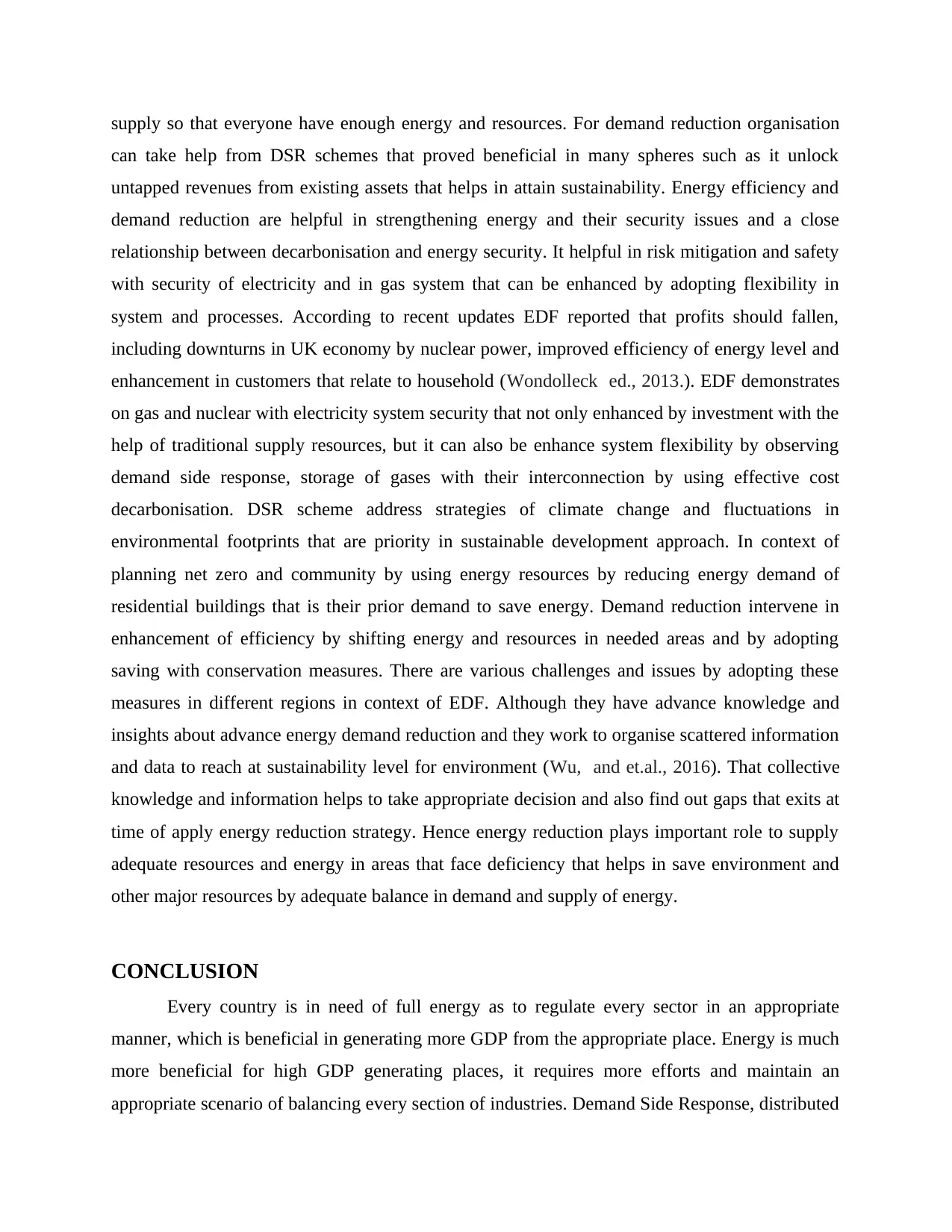
supply so that everyone have enough energy and resources. For demand reduction organisation
can take help from DSR schemes that proved beneficial in many spheres such as it unlock
untapped revenues from existing assets that helps in attain sustainability. Energy efficiency and
demand reduction are helpful in strengthening energy and their security issues and a close
relationship between decarbonisation and energy security. It helpful in risk mitigation and safety
with security of electricity and in gas system that can be enhanced by adopting flexibility in
system and processes. According to recent updates EDF reported that profits should fallen,
including downturns in UK economy by nuclear power, improved efficiency of energy level and
enhancement in customers that relate to household (Wondolleck ed., 2013.). EDF demonstrates
on gas and nuclear with electricity system security that not only enhanced by investment with the
help of traditional supply resources, but it can also be enhance system flexibility by observing
demand side response, storage of gases with their interconnection by using effective cost
decarbonisation. DSR scheme address strategies of climate change and fluctuations in
environmental footprints that are priority in sustainable development approach. In context of
planning net zero and community by using energy resources by reducing energy demand of
residential buildings that is their prior demand to save energy. Demand reduction intervene in
enhancement of efficiency by shifting energy and resources in needed areas and by adopting
saving with conservation measures. There are various challenges and issues by adopting these
measures in different regions in context of EDF. Although they have advance knowledge and
insights about advance energy demand reduction and they work to organise scattered information
and data to reach at sustainability level for environment (Wu, and et.al., 2016). That collective
knowledge and information helps to take appropriate decision and also find out gaps that exits at
time of apply energy reduction strategy. Hence energy reduction plays important role to supply
adequate resources and energy in areas that face deficiency that helps in save environment and
other major resources by adequate balance in demand and supply of energy.
CONCLUSION
Every country is in need of full energy as to regulate every sector in an appropriate
manner, which is beneficial in generating more GDP from the appropriate place. Energy is much
more beneficial for high GDP generating places, it requires more efforts and maintain an
appropriate scenario of balancing every section of industries. Demand Side Response, distributed
can take help from DSR schemes that proved beneficial in many spheres such as it unlock
untapped revenues from existing assets that helps in attain sustainability. Energy efficiency and
demand reduction are helpful in strengthening energy and their security issues and a close
relationship between decarbonisation and energy security. It helpful in risk mitigation and safety
with security of electricity and in gas system that can be enhanced by adopting flexibility in
system and processes. According to recent updates EDF reported that profits should fallen,
including downturns in UK economy by nuclear power, improved efficiency of energy level and
enhancement in customers that relate to household (Wondolleck ed., 2013.). EDF demonstrates
on gas and nuclear with electricity system security that not only enhanced by investment with the
help of traditional supply resources, but it can also be enhance system flexibility by observing
demand side response, storage of gases with their interconnection by using effective cost
decarbonisation. DSR scheme address strategies of climate change and fluctuations in
environmental footprints that are priority in sustainable development approach. In context of
planning net zero and community by using energy resources by reducing energy demand of
residential buildings that is their prior demand to save energy. Demand reduction intervene in
enhancement of efficiency by shifting energy and resources in needed areas and by adopting
saving with conservation measures. There are various challenges and issues by adopting these
measures in different regions in context of EDF. Although they have advance knowledge and
insights about advance energy demand reduction and they work to organise scattered information
and data to reach at sustainability level for environment (Wu, and et.al., 2016). That collective
knowledge and information helps to take appropriate decision and also find out gaps that exits at
time of apply energy reduction strategy. Hence energy reduction plays important role to supply
adequate resources and energy in areas that face deficiency that helps in save environment and
other major resources by adequate balance in demand and supply of energy.
CONCLUSION
Every country is in need of full energy as to regulate every sector in an appropriate
manner, which is beneficial in generating more GDP from the appropriate place. Energy is much
more beneficial for high GDP generating places, it requires more efforts and maintain an
appropriate scenario of balancing every section of industries. Demand Side Response, distributed

generation and demand reduction are three most unique services which examine all reduction and
distribution of power in a way to provide every facility on every corner at an urgent time of an
event. It focuses on force of demand and supply in market and maintain a full fledge game plan
to supply every urgency in Country.
distribution of power in a way to provide every facility on every corner at an urgent time of an
event. It focuses on force of demand and supply in market and maintain a full fledge game plan
to supply every urgency in Country.
⊘ This is a preview!⊘
Do you want full access?
Subscribe today to unlock all pages.

Trusted by 1+ million students worldwide
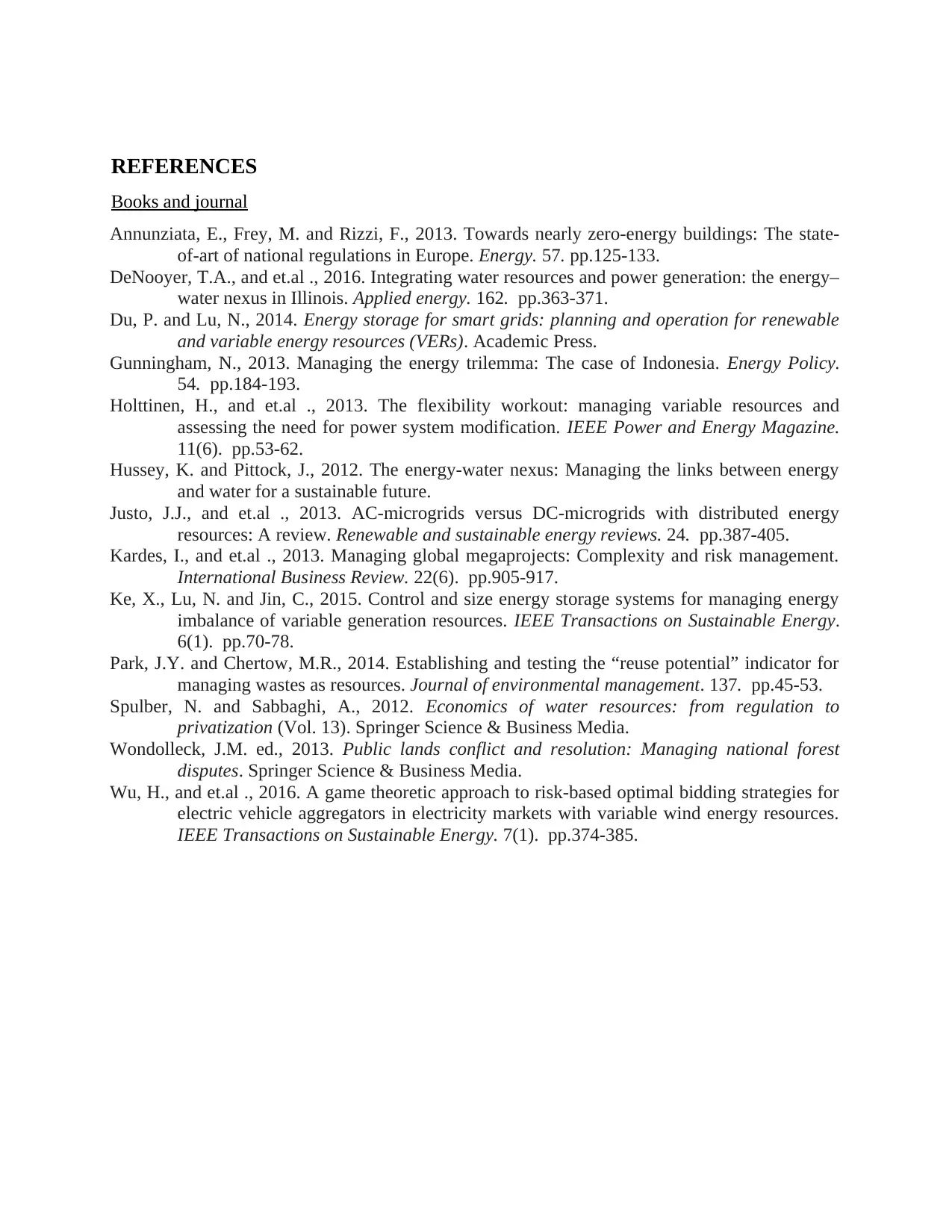
REFERENCES
Books and journal
Annunziata, E., Frey, M. and Rizzi, F., 2013. Towards nearly zero-energy buildings: The state-
of-art of national regulations in Europe. Energy. 57. pp.125-133.
DeNooyer, T.A., and et.al ., 2016. Integrating water resources and power generation: the energy–
water nexus in Illinois. Applied energy. 162. pp.363-371.
Du, P. and Lu, N., 2014. Energy storage for smart grids: planning and operation for renewable
and variable energy resources (VERs). Academic Press.
Gunningham, N., 2013. Managing the energy trilemma: The case of Indonesia. Energy Policy.
54. pp.184-193.
Holttinen, H., and et.al ., 2013. The flexibility workout: managing variable resources and
assessing the need for power system modification. IEEE Power and Energy Magazine.
11(6). pp.53-62.
Hussey, K. and Pittock, J., 2012. The energy-water nexus: Managing the links between energy
and water for a sustainable future.
Justo, J.J., and et.al ., 2013. AC-microgrids versus DC-microgrids with distributed energy
resources: A review. Renewable and sustainable energy reviews. 24. pp.387-405.
Kardes, I., and et.al ., 2013. Managing global megaprojects: Complexity and risk management.
International Business Review. 22(6). pp.905-917.
Ke, X., Lu, N. and Jin, C., 2015. Control and size energy storage systems for managing energy
imbalance of variable generation resources. IEEE Transactions on Sustainable Energy.
6(1). pp.70-78.
Park, J.Y. and Chertow, M.R., 2014. Establishing and testing the “reuse potential” indicator for
managing wastes as resources. Journal of environmental management. 137. pp.45-53.
Spulber, N. and Sabbaghi, A., 2012. Economics of water resources: from regulation to
privatization (Vol. 13). Springer Science & Business Media.
Wondolleck, J.M. ed., 2013. Public lands conflict and resolution: Managing national forest
disputes. Springer Science & Business Media.
Wu, H., and et.al ., 2016. A game theoretic approach to risk-based optimal bidding strategies for
electric vehicle aggregators in electricity markets with variable wind energy resources.
IEEE Transactions on Sustainable Energy. 7(1). pp.374-385.
Books and journal
Annunziata, E., Frey, M. and Rizzi, F., 2013. Towards nearly zero-energy buildings: The state-
of-art of national regulations in Europe. Energy. 57. pp.125-133.
DeNooyer, T.A., and et.al ., 2016. Integrating water resources and power generation: the energy–
water nexus in Illinois. Applied energy. 162. pp.363-371.
Du, P. and Lu, N., 2014. Energy storage for smart grids: planning and operation for renewable
and variable energy resources (VERs). Academic Press.
Gunningham, N., 2013. Managing the energy trilemma: The case of Indonesia. Energy Policy.
54. pp.184-193.
Holttinen, H., and et.al ., 2013. The flexibility workout: managing variable resources and
assessing the need for power system modification. IEEE Power and Energy Magazine.
11(6). pp.53-62.
Hussey, K. and Pittock, J., 2012. The energy-water nexus: Managing the links between energy
and water for a sustainable future.
Justo, J.J., and et.al ., 2013. AC-microgrids versus DC-microgrids with distributed energy
resources: A review. Renewable and sustainable energy reviews. 24. pp.387-405.
Kardes, I., and et.al ., 2013. Managing global megaprojects: Complexity and risk management.
International Business Review. 22(6). pp.905-917.
Ke, X., Lu, N. and Jin, C., 2015. Control and size energy storage systems for managing energy
imbalance of variable generation resources. IEEE Transactions on Sustainable Energy.
6(1). pp.70-78.
Park, J.Y. and Chertow, M.R., 2014. Establishing and testing the “reuse potential” indicator for
managing wastes as resources. Journal of environmental management. 137. pp.45-53.
Spulber, N. and Sabbaghi, A., 2012. Economics of water resources: from regulation to
privatization (Vol. 13). Springer Science & Business Media.
Wondolleck, J.M. ed., 2013. Public lands conflict and resolution: Managing national forest
disputes. Springer Science & Business Media.
Wu, H., and et.al ., 2016. A game theoretic approach to risk-based optimal bidding strategies for
electric vehicle aggregators in electricity markets with variable wind energy resources.
IEEE Transactions on Sustainable Energy. 7(1). pp.374-385.
1 out of 10
Related Documents
Your All-in-One AI-Powered Toolkit for Academic Success.
+13062052269
info@desklib.com
Available 24*7 on WhatsApp / Email
![[object Object]](/_next/static/media/star-bottom.7253800d.svg)
Unlock your academic potential
Copyright © 2020–2025 A2Z Services. All Rights Reserved. Developed and managed by ZUCOL.




